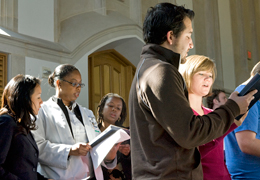Editor's note: This is part of a series of articles in which three United Methodist Church leaders explore disruptive innovation and what it means for the future of mainline Protestantism.
Fifty years ago, mainline Protestants were riding high. Church attendance was strong, and so were our prospects for continued vitality. We were leaders in shaping the ethos of the United States. After all, that’s why they called us the “mainline”! We seemed to have the same stability and high public profile as Bethlehem Steel, Radio Corporation of America (RCA) or IBM.
Today, however, people are just as likely to use the words “old line” or “sideline” to describe United Methodists, Presbyterians, Lutherans, Cooperative Baptists, Episcopalians and similar traditions. As membership continues to decline, mainline Protestants are afflicted by a crisis of confidence. Our once-certain future now looks more like accelerating decay than vitality. Whether our congregations and denominations are just “showing their age” or have begun to go the way of Bethlehem Steel and RCA, the prospects seem bleak.
The finger-pointing has already begun. Deep divisions about ordination, sexuality and other social issues are part of the dynamics shaping mainline Protestantism, now and into the future. Some have pointed to failures of leadership among our forebears: if only they had been better preachers, or teachers, or visionaries -- or all of the above. Undoubtedly, failures of leadership have occurred, both then and now.
Yet Clayton Christensen, the noted Harvard Business School professor, has pointed to a deeper wisdom about what often happens to large organizations such as mainline Protestantism. He argues in his theory of “disruptive innovation” that even established organizations with good leadership -- indeed, especially organizations with good leadership -- can become blind to disruptive forces around them. They don’t see the need to change until it is too late.
The better the leadership, Christensen explains, the more likely it is that an established organization has an excellent business model that is producing excellent results. Why pay attention to disruptive forces around the edges that are producing lower-quality goods at lower profits when the prospects for profits in the next several years are promising and stable?
Bethlehem Steel didn’t need to pay attention to the disruptive rebar minimills of Nucor; RCA didn’t need to pay attention to the disruptive Walkman radios of Sony; IBM didn’t need to pay attention to the disruptive personal computers of Apple. They were all making great profits on higher-end steel, televisions and radios, and mainframe computers, respectively. They didn’t need to pay attention, they thought. Until it was too late.
While Bethlehem, RCA and IBM forged ahead as they had always done, Nucor, Sony and Apple began at the bottom of the market with inferior products, Christensen argues. But slowly their new technologies took hold, and they moved up the market until they had displaced the established organizations. The established organizations had great business models … until they collapsed.
We believe Christensen’s theory of disruptive innovation is relevant to the plight of mainline Protestantism. We had successful models for organization and leadership … until we didn’t. We mainline Protestants didn’t pay adequate attention to multiple disruptive forces occurring within both the religious realm and, more broadly, American culture and the world.
We didn’t realize that new disruptive forces were appearing in such areas as youth ministry and leadership development for laity and clergy. We didn’t notice huge shifts in how people congregate and meet and share with one another. We were blind to the broader cultural trends related to globalization, immigration and new technological innovations.
While we focused on doing ministry the way we always had, others came along and developed innovation at the “lower end of the market” in ways that we initially ignored. Even when we noticed, we largely sneered at initiatives that seemed to be of poorer quality and less influential.
Our story thus far is depressing. Is mainline Protestantism on life support, headed toward inevitable death? Because of their bottom-line pressures, companies go out of business faster than nonprofits do. Are we the next Bethlehem Steel or RCA, just on a slower path to oblivion?
We do not believe so. As Christensen notes, established organizations don’t have to be flattened by disruptive innovation. Indeed, they can embrace it -- if they change their practices. To do that, they need to create “skunk works” -- walled-off initiatives that are protected from the established ways of doing things and supported by people with “heavyweight” credibility. Freed up to innovate, these initiatives cultivate experiments that enable the established organization to learn new ways of doing things.
IBM offers an instructive example of revival. In the late 1980s and early 1990s, it was headed toward extinction. But under the leadership of Louis Gerstner, an outsider to the technology industry who became CEO in 1993, IBM underwent a culture change. As a result, IBM created various internal skunk works with the protection and support necessary for growth and ongoing sustainability.
Can mainline Protestants, especially United Methodists, become like IBM rather than Bethlehem Steel and RCA? Can we rediscover vitality and growth by developing mindsets, activities and traits that embrace disruptive innovation?
We believe the answer to such questions is yes, but it won’t be easy. We will have to rediscover the disruptive innovations in Christian history and tell the stories of our own tradition in fresh ways. And we must become open to the fresh winds of the Holy Spirit who is, indeed, “making all things new” by conforming us to Christ. As Greg has suggested elsewhere, our ability to embrace disruptive forces in the church will invite us into a theological appropriation of traditioned innovation .
Mainline Protestants can still have an exciting and life-giving future. Living into that future will require us to learn deeply the lessons of disruption (as we will explore in subsequent reflections), and to do so in ways that invite both theological reinvigoration and savvy organizational design and leadership.


















